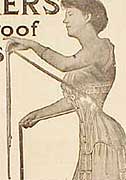|
|
|
The way people get their clothes has always reflected the technology of the day. Up to the early nineteenth century, there was no way to mass-produce clothing. So women got their clothes in one of three ways: they bought them used; they made them; or they had them made. There were no stores offering new ready-made clothing in the way stores do today. Seamstresses offered custom dressmaking services to those who could afford them. Men went to tailors or, like the women, bought used clothing or had clothes made by female relatives. By the middle of the nineteenth century, some garments began to be offered ready-made–generally cloaks and corsets, adjustable items that could be standardized in their sizing. By the 1870s, ready-made underwear was also available. Other ready-made garments were still pretty crude, however, so there was not much market for ready-made dresses and other fine clothing. As the nineteenth century progressed, however, new machinery improved the manufacture of clothing; extended rail systems made distribution of ready-made clothing easier; and the telegraph and telephone streamlined the ordering process, thus allowing the rise of department stores that could control the costs of inventory while offering the latest merchandise to their customers. At the turn of the twentieth century, retail trade in ready-made clothing was poised to take off.
These were definitely services for the wealthy. The average woman might dream of having a single gown made for her, but could hardly imagine having her entire wardrobe outfitted by a custom dressmaker. The new department stores filled the need to clothe an increasingly active group of working women without the resources to afford custom work, but also lacking the time to sew there own clothes. The Tirocchi clients prefered the environment of their shop to the developing retail establishments. A custom dressmaker provided the most personal of services to her clients. She took the client’s measurements and recorded them in a book for future use. If the client was a good one, she might even have a dress form made to her specifications to aid in fitting the gowns properly. At least once during the process of making a gown, the client would have to come in for a fitting, in which the partially completed garment would be tried on and adjusted for the right fit. Women of the wealthier classes preferred that these intimate transactions take place in comfortable settings, with dressmakers they knew. The idea of going Downtown to a new department store with unknown fitters and seamstresses was out of the question. This personalized service was expensive. The Tirocchis’ clients felt the expense was necessary to ensure that their clothing fit perfectly, was personally flattering to them, and was unlike any other gown they could see on their friends. The latter point is important to realize. Madame Tirocchi stocked luxurious fabrics and trims and decorations and worked with her customers individually to choose the most flattering combination of these materials, then pick a design for the gown. She would never duplicate a gown for another client. Clients might choose similar designs and fabrics, but their gowns would be unique. Because clothing was so expensive, even wealthy women economized by having gowns re-made after a year or two. They would take a dress back to the Tirocchi shop to have it re-cut into a different style, or to have new trim and buttons substituted for the originals. By refreshing their wardrobes in this way, they could extend their investment in very expensive materials while achieving a new look. The practice of having gowns re-made was more than a matter of expense alone, however. Consumers at the beginning of the twenty-first century are accustomed to a "throw away" society in which clothes are disposed of when they lose their appeal or fit. Early twentieth century consumers would have disapproved of such a careless attitude. Even these women, who could well afford new garments every year, subscribed to a general frugality in their purchases. It was during the late nineteenth century that Anna Tirocchi was trained as a seamstress. Many women learned to sew, but she clearly showed the talent in design and craftsmanship to become a custom dressmaker of the first rank. She reportedly apprenticed with a noted Roman dressmaker whose clients were Italian royalty and aristocracy. And though ready-made clothing was improving in the United States by the time she arrived in 1905, wealthy American women still relied on talented dressmakers to design and make their gowns. Anna Tirocchi and her sister Laura, also trained as a seamstress, vowed to serve these elite women, ignoring threats to their livelihood from changing fashion and retailing.
^back to
top
|
|
The
STORIES |
|
|
|
|
